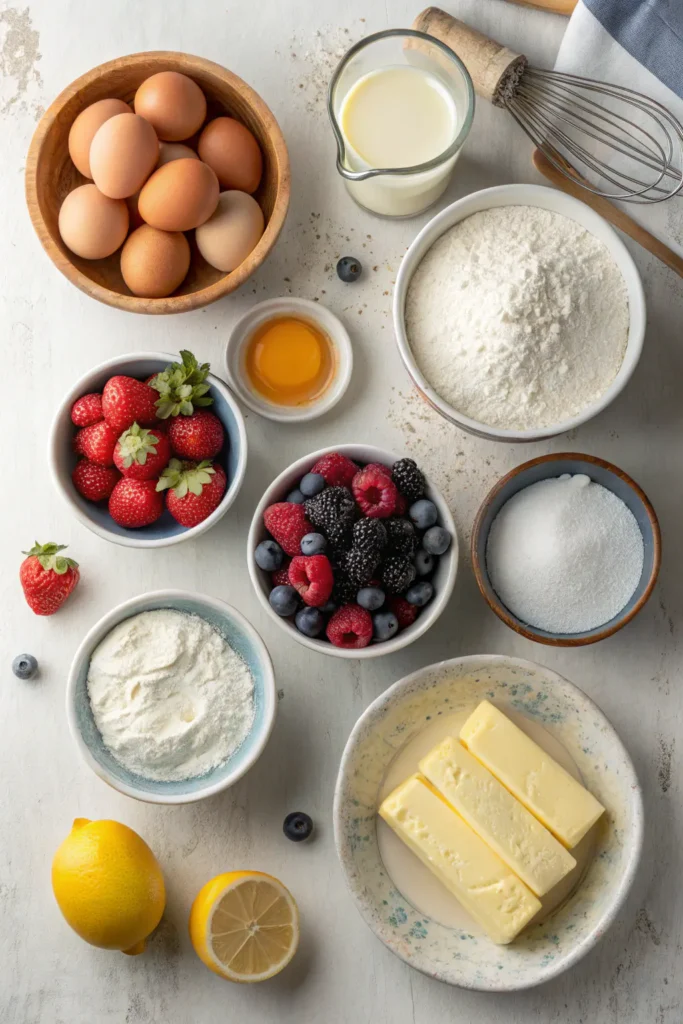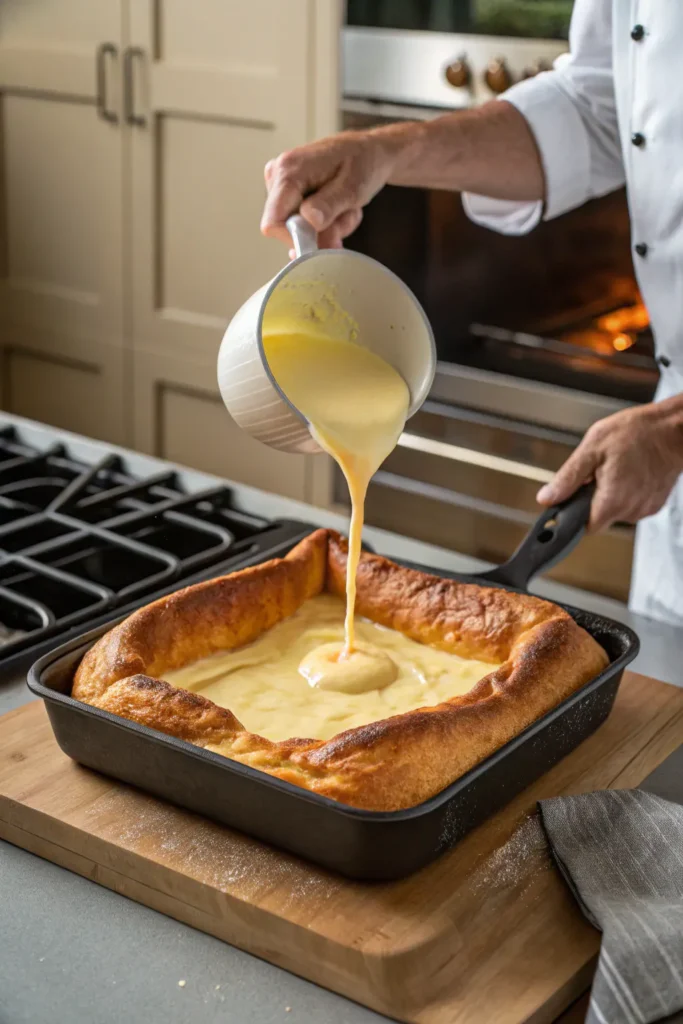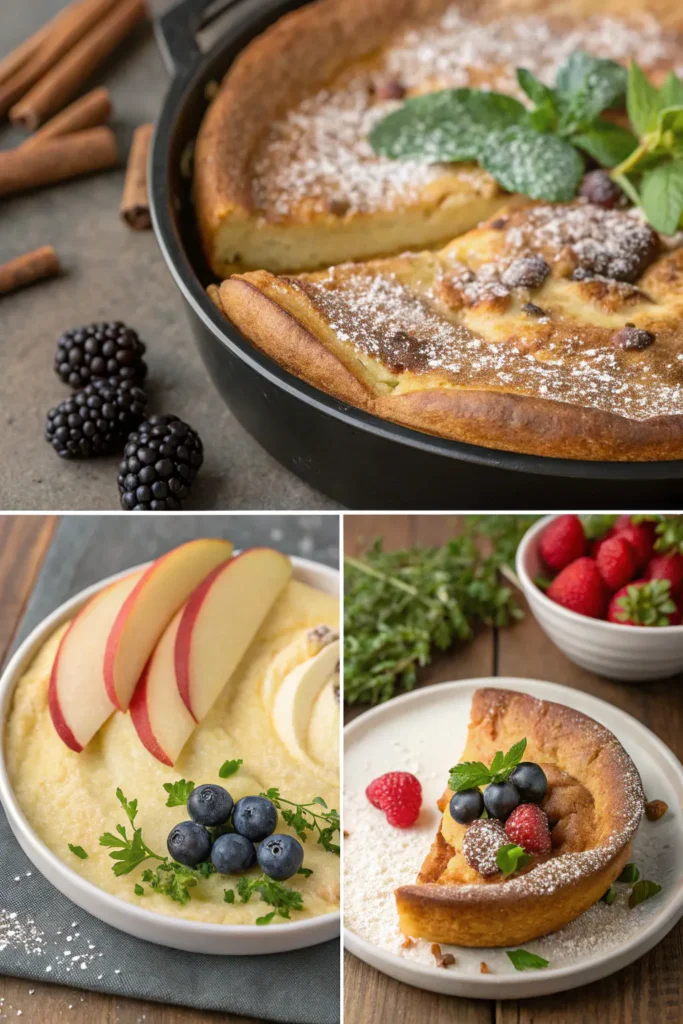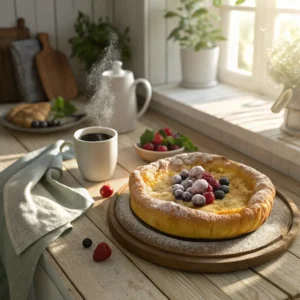Table of Contents
Have you ever craved a breakfast that’s both simple to prepare and delightfully impressive? Enter the Baked German Pancake, also known as a Dutch Baby—a dish that magically puffs up in the oven, creating golden, crispy edges with a tender, custard-like center. Made from basic ingredients like eggs, milk, and flour, this versatile pancake offers endless possibilities for toppings, from fresh berries to a dusting of powdered sugar. Whether you’re hosting a brunch or seeking a cozy family breakfast, this recipe promises to elevate your mornings with minimal effort and maximum flavor
Key Benefits of Baked German Pancakes
Baked German Pancakes, often called Dutch Babies, are a delightful addition to any breakfast or brunch. Here’s why they stand out:
- Simplicity: With just a handful of basic ingredients—eggs, milk, flour, and butter—you can whip up this dish in no time.
- Visual Appeal: As they bake, these pancakes puff up dramatically, creating a stunning centerpiece that’s sure to impress your guests.
- Versatility: Their neutral flavor profile allows for a variety of toppings, from sweet options like fresh berries and powdered sugar to savory choices like sautéed vegetables and cheese.
- Family-Friendly: Kids and adults alike enjoy the unique texture and taste, making it a hit at family gatherings.
- Quick Preparation: Requiring minimal prep time, they are perfect for both busy mornings and leisurely weekends.
Ingredients
To make a classic Baked German Pancake, you’ll need:

- 6 large eggs
- 1 cup all-purpose flour
- 1 cup milk
- 1/2 teaspoon salt
- 1 teaspoon vanilla extract
- 2 tablespoons butter
Optional Toppings:
- Powdered sugar
- Fresh berries
- Maple syrup
- Lemon wedges
Step-by-Step Guide to Perfect Baked German Pancakes
Imagine embarking on a culinary adventure that transforms simple ingredients into a show-stopping breakfast. Follow these clear, actionable steps to create a Baked German Pancake that’s both light and irresistibly crispy:

- Preheat Your Oven
- Set your oven to 425°F (220°C).
- Place your baking dish inside to ensure it’s piping hot when you add the batter.
- Blend Your Batter
- Combine eggs, milk, all-purpose flour, salt, and vanilla extract in a blender.
- Blend until the mixture is completely smooth to ensure an even texture.
- Prepare the Baking Dish
- Carefully remove the hot dish from the oven.
- Add butter and swirl it around until the bottom and sides are well coated.
- Pour and Bake
- Pour the smooth batter into the hot, buttered dish.
- Return the dish to the oven and bake for 20-25 minutes, watching as the pancake dramatically puffs up and turns golden along the edges.
- Troubleshooting Tips
- If your pancake isn’t rising: Double-check that your oven and dish were adequately preheated.
- If you encounter lumps: Ensure your batter is well-blended; using a blender can help achieve that ideal consistency.
- For extra crispiness: Consider extending the bake by a couple of minutes while keeping a close eye on the color.
- Final Touches
By following these steps, you’re well on your way to mastering a breakfast classic that’s as delightful to make as it is to eat. Enjoy the process and feel free to tweak the recipe to match your personal taste—happy baking!
Pro Tips and Variations
Enhancing your Baked German Pancake experience is both fun and rewarding. Here are some insider tips and creative twists to elevate your dish:
- Room-Temperature Ingredients: Using room-temperature eggs and milk ensures a smoother batter and better rise. If you’re short on time, place cold eggs in warm water for about 10 minutes to warm them up.
- Blender Method: For a lump-free batter, combine your ingredients in a blender. This technique not only ensures smoothness but also incorporates air, contributing to the pancake’s signature puffiness.
- Preheat the Pan: Before adding the batter, place your butter in the baking dish and let it melt in the preheating oven. Pouring the batter into a hot, buttered pan helps achieve those delightful crispy edges.
- Flavor Enhancements: Introduce a pinch of cinnamon or nutmeg to the batter for added warmth. Alternatively, a splash of almond extract can provide a subtle, nutty aroma.
- Fruit Infusions: Layer thinly sliced apples, pears, or berries over the batter before baking. As the pancake cooks, the fruits soften and caramelize, adding natural sweetness and texture.
- Savory Twist: For a savory version, omit the vanilla extract and sugar. Incorporate chopped herbs like chives or parsley into the batter, and top with grated cheese, sautéed mushrooms, or crispy bacon bits.
- Alternative Flours: Experimenting with different flours can yield unique textures and flavors. Whole wheat flour adds a hearty, nutty taste, while gluten-free blends cater to dietary preferences without compromising puffiness.
- Individual Servings: For personalized portions, divide the batter into preheated muffin tins or ramekins. This approach not only offers charming presentation but also reduces baking time.
- Citrus Zest: Incorporate grated lemon or orange zest into the batter to introduce a refreshing citrus note, balancing the pancake’s richness.
- Buttermilk Variation: Substituting regular milk with buttermilk imparts a subtle tanginess and tender crumb, enhancing the overall flavor profile.
Remember, the beauty of the Baked German Pancake lies in its versatility. Don’t hesitate to experiment with different flavors and ingredients to make it uniquely yours. Happy cooking!

Serving Suggestions for Your Baked German Pancake
Elevate your breakfast or brunch experience with creative serving ideas that transform your Dutch Baby into a true showstopper. Here are some practical, mouthwatering suggestions:
- Classic Presentation:
- Dust the pancake lightly with powdered sugar.
- Add a squeeze of fresh lemon juice for a tangy contrast.
- Berry Bliss:
- Top with a vibrant mix of fresh berries such as strawberries, blueberries, or raspberries.
- Drizzle warm maple syrup or honey for an extra layer of sweetness.
- Nutty Crunch:
- Sprinkle chopped nuts (like almonds, walnuts, or pecans) over the pancake.
- For added texture, consider a dollop of Greek yogurt or a swirl of whipped cream.
- Savory Twist:
- For a more adventurous palate, pair your pancake with crispy bacon, sautéed mushrooms, or a sprinkle of fresh herbs like chives and parsley.
- A light drizzle of olive oil or a few dollops of ricotta can balance the flavors beautifully.
- Personalized Portions:
- Serve the pancake in individual portions using ramekins or muffin tins for a charming, shareable presentation.
- This approach not only enhances visual appeal but also offers customizable topping options for each guest.
By incorporating these serving suggestions, you can tailor your Baked German Pancake to suit any occasion. Experiment with these ideas to find your favorite combination, and enjoy the process of making your meal both delightful to the eye and the palate.
Embrace the Joy of Baking
As you wrap up your Baked German Pancake journey, take a moment to appreciate how a few simple ingredients can create a breakfast masterpiece. This recipe is all about celebrating the art of effortless cooking while enjoying a visually stunning dish that’s perfect for both cozy mornings and festive brunches.

Baked German Pancake
Ingredients
- 6 large eggs
- 1 cup all-purpose flour
- 1 cup milk
- 1/2 teaspoon salt
- 1 teaspoon vanilla extract
- 2 tablespoons butter
Optional Toppings:
- Powdered sugar
- Fresh berries
- Maple syrup
- Lemon wedges
Instructions
Preheat Your Oven
- Set your oven to 425°F (220°C).
- Place your baking dish inside to ensure it’s piping hot when you add the batter.
Blend Your Batter
- Combine eggs, milk, all-purpose flour, salt, and vanilla extract in a blender.
- Blend until the mixture is completely smooth to ensure an even texture.
Prepare the Baking Dish
- Carefully remove the hot dish from the oven.
- Add butter and swirl it around until the bottom and sides are well coated.
Pour and Bake
- Pour the smooth batter into the hot, buttered dish.
- Return the dish to the oven and bake for 20-25 minutes, watching as the pancake dramatically puffs up and turns golden along the edges.
Troubleshooting Tips
- If your pancake isn’t rising: Double-check that your oven and dish were adequately preheated.
- If you encounter lumps: Ensure your batter is well-blended; using a blender can help achieve that ideal consistency.
- For extra crispiness: Consider extending the bake by a couple of minutes while keeping a close eye on the color.
Final Touches
- By following these steps, you’re well on your way to mastering a breakfast classic that’s as delightful to make as it is to eat. Enjoy the process and feel free to tweak the recipe to match your personal taste—happy baking!
Notes
- Calories: 300 kcal
- Total Fat: 0.53 oz
- Protein: 0.35 oz
- Carbohydrates: 1.06 oz
- Fiber: 0.07 oz
- Sugar: 0.18 oz
FAQs
What are German Pancakes?
German Pancakes, often known as Dutch babies, are a delightful oven-baked treat characterized by their dramatic rise, crispy edges, and tender, custard-like center. Made with a simple batter of eggs, milk, flour, and a hint of vanilla or salt, these pancakes puff up impressively in a hot, buttered baking dish. They offer a versatile canvas that works wonderfully with both sweet toppings like fresh berries, powdered sugar, and maple syrup, as well as savory additions such as herbs and cheese. Originating from Germany and popularized in American brunch culture, German Pancakes are celebrated for their unique texture and ease of preparation, making them a favorite for any meal of the day.
Can I prepare the batter in advance?
Yes, you can prepare the batter the night before and store it in the refrigerator. Give it a quick whisk before pouring into the preheated dish.
Why didn’t my pancake puff up?
Ensure your oven and baking dish are thoroughly preheated. Cold batter hitting a hot surface creates the signature puff.
How do I store leftovers?
Store any leftovers in an airtight container in the refrigerator for up to two days. Reheat in the oven to retain some crispness.
Can I make this gluten-free?
Absolutely! Substitute the all-purpose flour with a gluten-free flour blend suitable for baking.
What’s the difference between a German pancake and a Dutch baby?
They’re essentially the same dish. “Dutch baby” is an American term, while “German pancake” references its European roots.


1 thought on “Baked German Pancake”